“McGill was an innocent bystander walking in the area when she was struck by an out-of-control vehicle.”
– Portland Police Bureau
Note: This article contains opinions.
Last night dozens of people gathered on Southeast Stark near 133rd to remember Ashlee McGill. The 26-year-old was standing on the sidewalk, waiting for the Line 20 bus around 5:30 am this past Saturday when she was hit and killed by someone driving a car.
Police initially assumed the deceased person they found at the scene was the driver. But in an updated statement released Thursday they shared that upon further investigation, McGill was just an “innocent bystander…. struck by an out-of-control vehicle.” Local news stories confirm that McGill was just waiting for a bus to take her home. PPB also says the driver who hit her was racing another driver prior to the crash that killed McGill.
It’s just the latest tragedy caused by the tragic mix of illegal street racing and deadly road designs that make it possible.
SE Stark is a drag strip. It’s tailor-made for doing one thing: going fast in a car. Nothing excuses what these criminal drivers do, but we are fooling ourselves if we think road design doesn’t play a factor in these terrible outcomes.
Since 2016, thirteen people have died in traffic crashes on SE Stark in just a 1.8 mile section between SE 122nd and SE 160th. 13 people. Dead. On the same stretch of road. And these weren’t drivers just making a mistake on a tricky stretch of road. The profile of Stark in this location is wide, straight, and the visibility is excellent. Reading through the causes of these deaths almost all of them were some combination of criminal negligence, hit-and-run, or drunk and reckless driving. Or in this latest case, street racing.
The City of Portland is well aware of these dangers. According to the Portland Bureau of Transportation, Stark is a designated high crash corridor where high speeds are common. If the 13 deaths mentioned above, seven of them were people walking. PBOT says speed was about three times more common a factor in pedestrian crashes on SE Stark Street as it is citywide.
PBOT lowered the speed limit on this section of Stark to 30 mph in April 2018. They also deployed photo radar vans after the changes and worked with Portland Police Bureau to enforce the lower speeds. But it hasn’t been nearly enough. Nine people have died since the speed was lowered.
In April of this year PBOT installed it’s first-ever “intersection safety camera” at Stark and SE 122nd. But that’s just one intersection, and it’s 11 blocks from where these drivers chose to race their cars.
Nine people have died in the past four years on this section of Stark. We are on pace to see five more people killed by the time this project wraps up.
These were just PBOT’s first moves to tame Stark. They’ve got $20 million lined up to do more. Their plan is to spend half the money on new pavement and the other half to add bike lanes, signal upgrades, ADA ramps, two protected intersections, better crossings, more street lights, and so on. The Outer Stark Safety Project will go from SE 102nd to Portland’s eastern border with Gresham at SE 162nd. Open houses for the project were held in 2019 and PBOT had planned to install some of the initial elements this past spring.
But in a phone call with PBOT Interim Communications Director Hannah Schafer this morning, I learned that the project hasn’t started yet. PBOT is still finalizing the project scope with their consultant and the design phase of the project will begin this fall. Schafer said construction won’t begin until 2024.
Nine people have died in the past four years on this section of Stark. We are on pace to see five more people killed by the time this project wraps up.
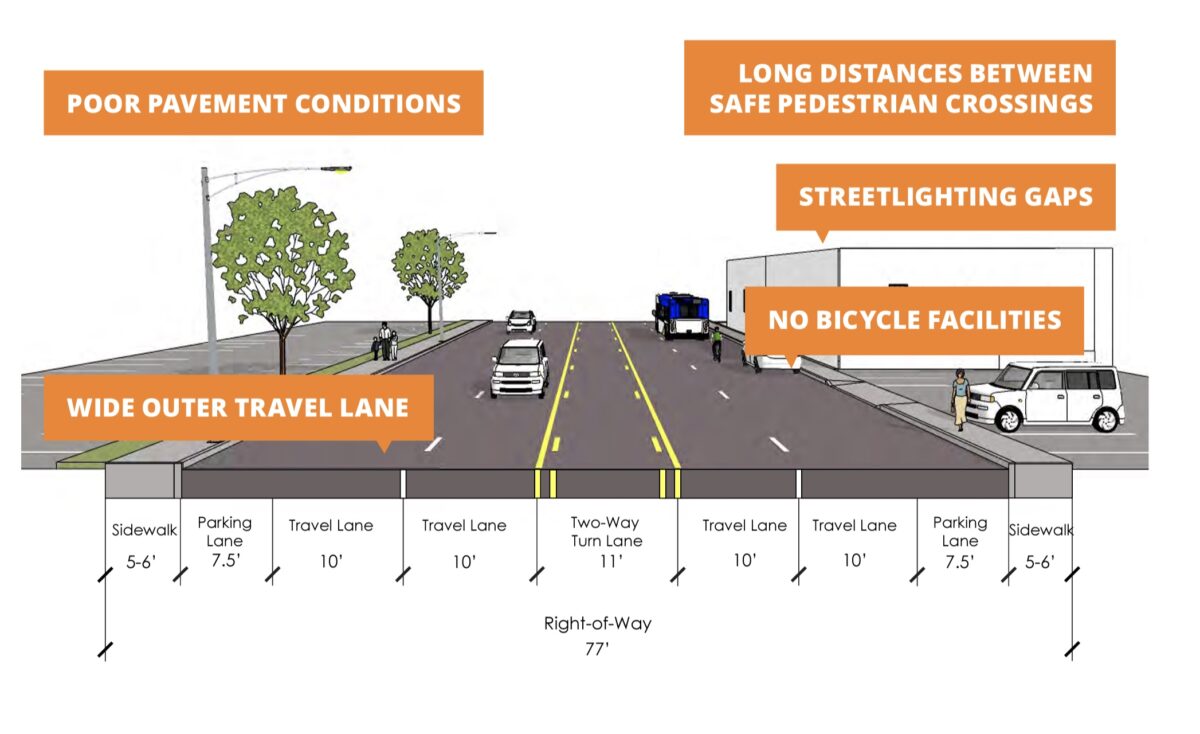
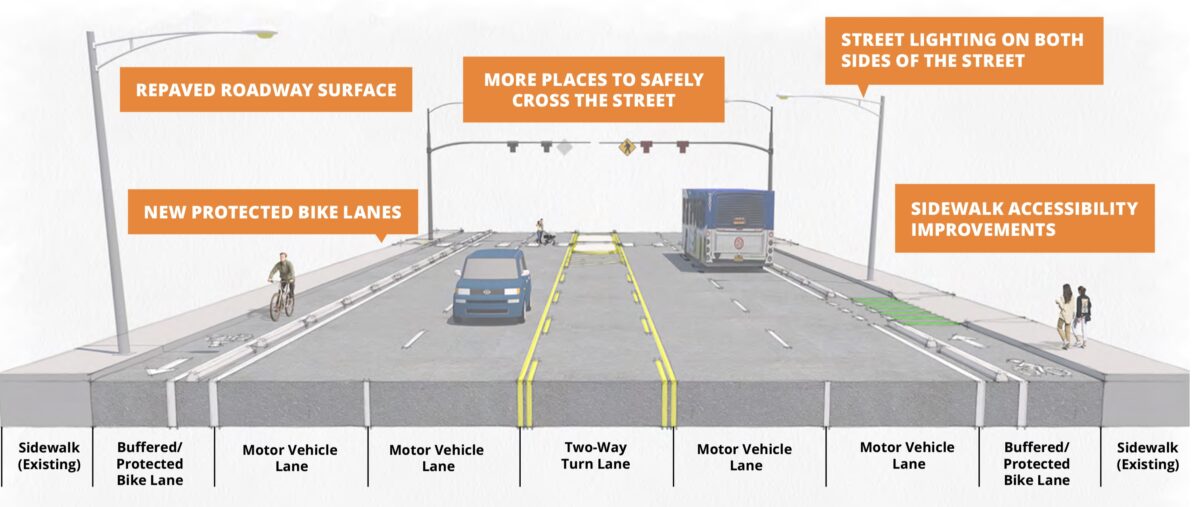
And will the changes even do anything? The new cross-section proposed by PBOT looks a lot like the current one. There will still be five lanes for driving. Yes they’ll be narrower and we’ll have protected bike lanes instead of parking lanes, but the overall space for driving won’t change that much. It will still be very easy to speed — even to race — on the new SE Stark we will have waited over six years for and spent $20 million on.
I worry that even though PBOT means well, their designs for these east Portland arterials are much too timid. Despite all the back-patting at ribbon cuttings, the aggressive, dangerous, criminal, dysfunctional driving behaviors will remain. I’ve been saying this for many years, but I still see the same approach where we focus efforts on improving conditions for walkers and bikers, but we fail to grab the bull (drivers) by the horns. The politics to “improve bike and ped safety” are easy. The politics to make it harder for people to drive like they’re in a car commercial, are not.
We design streets to be safe for politicians, and to be unsafe for people. This must change.
UPDATE, 2/16: Portland Police have arrested the driver who killed Ashlee McGill. The driver has been charged with Manslaughter. More info on PPB press release.



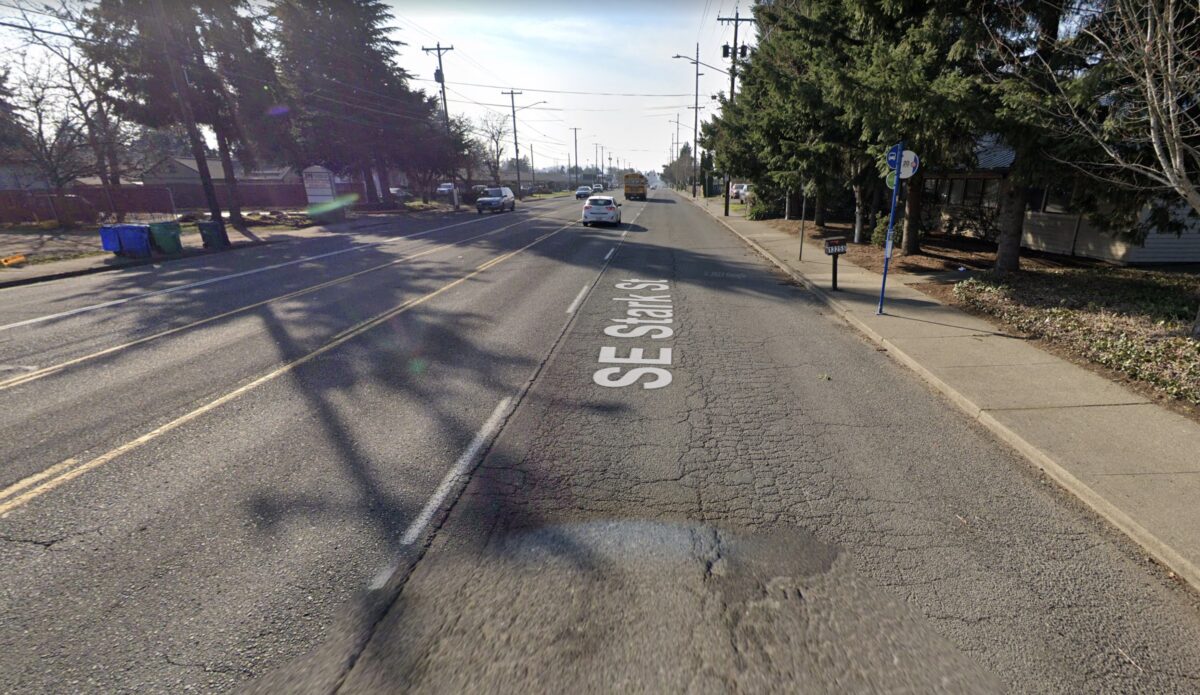
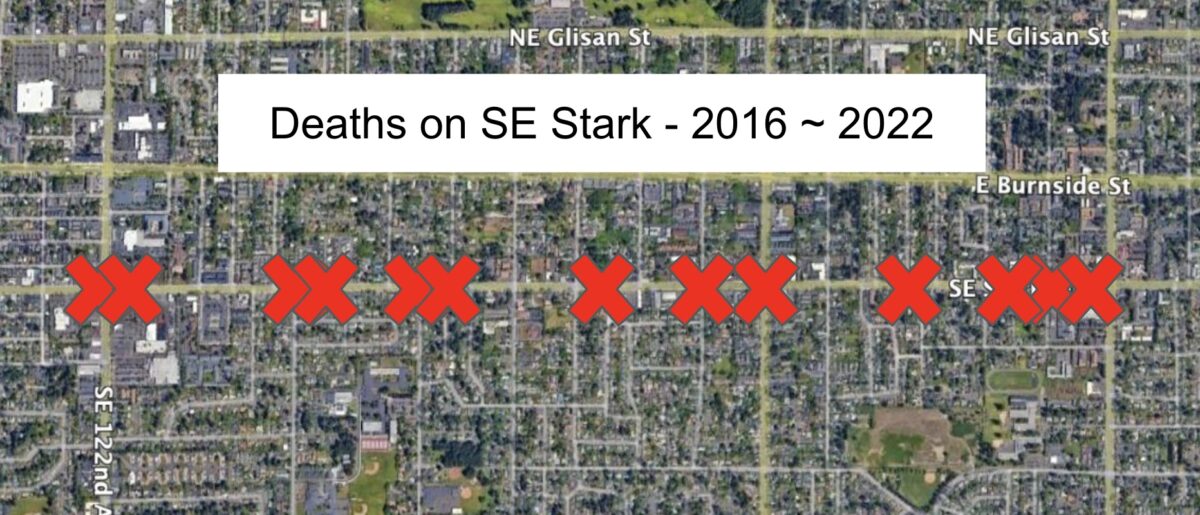
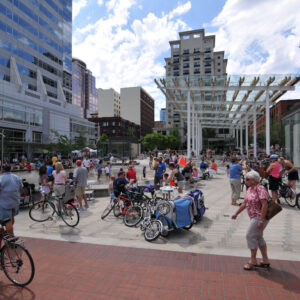
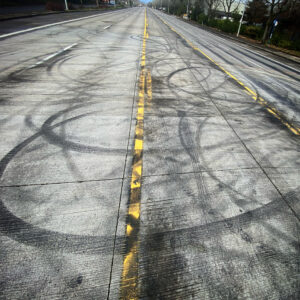
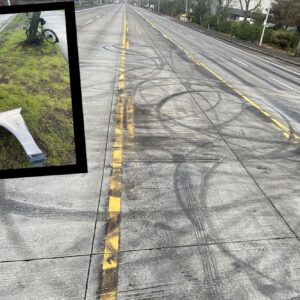
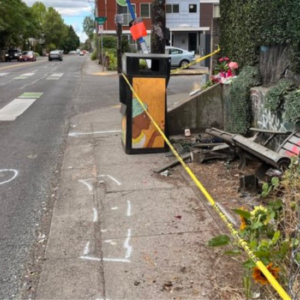
Thanks for reading.
BikePortland has served this community with independent community journalism since 2005. We rely on subscriptions from readers like you to survive. Your financial support is vital in keeping this valuable resource alive and well.
Please subscribe today to strengthen and expand our work.
Why no speed bumps?
Specifically, I think Stark would be a nice place to use raised (at-sidewalk-grade) crosswalks.
As a cyclist I find most speed bumps jarring. They affect people on bikes more than they do cars.
I’m so sad to hear this news. I believe that this road should have a dedicated bus lane.
No road in the city should have more than one car lane going in each direction along with the turn lanes.
One difference is the before has street trees and some greenery, and the after does not.
What more can you expect from a city that has street takeovers for racing every week at the same locations and at the same times, but is somehow unprepared for them? What message does that send to people that want to participate in this type of activity?
20 million spent and people still dying ? What sheer planning genius at work.
The project hasn’t started yet.
But if you ask the engineers at PBOT, they’ll tell you the project has already in fact started, they are now in the design stage – and knowing PBOT’s record in East Portland, they’ll still be designing 8 years from now with nothing meaningful implemented. But they will spend the money.
There should be a moratorium on PBOT starting any “new” improvements anywhere in the city until these high crash corridors are fixed. PBOT has lost its focus with too many things at once, no clear priorities.
You mean, like delay bike projects on NE 7th and downtown? Not implement expensive new bike bridges along non-high-crash-corridors?
Word, David.
Another difference is the after shows street lights in the middle of the sidewalk, where in the before, they’re on the edge. I would argue they should not be on the sidewalk at all, especially on such an important street. Maybe they could go between the car lanes and the bike lanes?
raised crosswalks at every bus stop.
Angled parking on every median, no left turns allowed. Force drivers to become pedestrians.
When is the traffic enforcement going to start back up? What are we even paying the cops to do in this town? End the blue flu now!!!
“A driver racing their car”
I would like to take this opportunity to offer my services, on a pro bono basis, as a grammar checker.
Hi Ernest, there has been a move to invent a gender-neutral pronoun in English for a while. In this case, sounds like Jonathan doesn’t know the sex of the driver. Anne Fadiman, editor par excellence, has even come to terms with it. Shakespeare used it, as did Jane Austin!
Fadiman wrote a great essay for Harpers, All my pronouns, How I learned to live with the singular they. She points out that “you” made a similar journey, starting as a plural only, and now representing plural and singular. We don’t say “you is,” but we should, if it’s singular.
“They” as a singular pronoun will always sound wrong to me. I now avoid all third-person pronouns and recommend others do also.
You probably use singular “they” all the time and don’t realize it. As this debate has made the rounds among writers and grammarians, the opponents of singular “they” are often embarrassed to be caught using it while making their arguments.
Even as a school-girl in the ’60s, I didn’t buy “he” and “Man” as including both sexes, and I don’t buy it now. “One small step for Man, one giant step for Mankind” leaves me out. That’s half the world.
Avoiding third person pronouns altogether makes for cumbersome writing and speech.
Hey I’m 70 and I have learned to say “they”. In my 1st grade a classmate said “someone left their coat on the closet”. The teacher corrected the classmate: “Someone left HIS coat in the closet”. Children said “but you don’t know if it’s a boy’s or a girl’s” . But the teacher insisted!
I agree that English needs a pronoun makeover. (Also, there is no “aunt” equivalent for the word “avuncular.”) At least English doesn’t assign a gender to every noun, however.
Can I just say that it is basically a propaganda term to describe the proposed bike lanes on Stark “protected”? Those little curbs will not actually protect cyclists from drunk drivers, people who are speeding and lose control of their car, and other plausible scenarios that might kill or maim cyclists on a high traffic road where it is possible to drive fast. As far as I can tell, those “protected” bike lanes just make it less likely that someone will park in the bike lane, but also make it harder to pass people and are kept inadequately clean.
Yes, let’s please stop repeating the lie that a mountable curb is “protection” in any meaningful sense. Anything short of a Jersey barrier will not protect you from a driver who can’t or won’t stay in their own lane.
I am not convinced that bike lanes on Stark are very useful. I would like to see the sidewalks widened to 7′-8′, a 4′-6′ planting strip added for street trees, Maybe the curbside lane could be a bike/bus lane with lane protection to prevent other drivers from cutting in. Also, the center trun lane could be massively reduced and planted with trees if there are no utility conflicts.
I think that there should definitely be bike lanes but I think the default for a street like that should be:
car lane –> street trees –> bike lane –> sidewalk (with the last two at the same height)
People have posted some incredible examples of that from elsewhere recently. It makes so much sense. The trees shade more of the street, they create a buffer for bikers, they don’t disrupt the sidewalk, they’re not forced into tiny grates…Street lights could go there too, so as not to interrupt the sidewalk, per Watt’s comment above.
More than a few of those two-way turn, a.k.a. “suicide” lanes could be turned into greenery and/or chicanes to discourage straight line speed.
On a busy street near me, quite a few trees have been taken out on the median and I dare to suggest that some people appreciate that it was the tree instead of them in a crossover collision.
If the city had actually adopted Vision Zero, the deaths would have stopped at one because the road would have been redesigned to force motorist to drive slow.
12 bodies late and PBOT still wont prioritize safety over speed
And won’t prioritize enforcement over death.
Enforcement is demonstrably less effective and far, far more costly over time than vision zero infrastructure and policy change (e.g. strict licensing and ISA speed limiters).
Unfortunately, Portland’s re-branding of 1950s era “3 Es” policy as “vision zero” was an unfunded farce from day 1.
It’s not either or. We need enforcement until we build our Vision Zero infrastructure and make policy changes.
The alternative, no enforcement until we build our Vision Zero infrastructure and make policy changes, is getting a lot of people killed.
There should be a red light camera at every signalized intersection and a speed camera in every block.
Fines should be a minimum of $200 and should double for each subsequent infraction during a 12 month period. Or just impound the vehicle for a year.
You only have one problem with that plan, The state of Oregon. Under current rules Portland has 18 speed cameras. House Bill 4105 signed this year and starting Jan 2023 will allow Portland to add 22 more cameras. It also changes the person reviewing the photo from a police officer to a trained city employee. It does not change the 11 MPH threshold or change the fact speed cameras can only run 4 hours each day.
Wow. Incredible. I didn’t know about the 4hr and 11mph nonsense. It’s like cars literally run this country, humans asleep at the proverbial wheel.
and, yet, many of the cycling enthusiasts who rant about speed cameras on this blog keep on voting for the SUV-loving democrats who expand freeways, ignore active transportation, and help maintain and expand the dehumanizing corporate-fascist state.
Well, the city could just break the law. Strange idea? Millions of us used cannabis pretty openly at times when it was against the law in Oregon, or elsewhere. Other examples exist.
I think you underestimate the correlation between red light runners and our “plateless portlanders”
I certainly hope the traffic division, the DA, or whomever is responsible invokes the VRU laws on this – since racing, by definition, is willfully reckless driving.
They should. Absolutely.
Problem is, that law is gutted by failure to apply it to behavior that is fully reckless because the mv operator ‘complied’ after the fact. Compliance doesn’t bring a person back from the morgue.
In this accounting of why people died on Stark, I’m seeing a poor sense of personal responsibility encouraged by our bad car culture rather than infrastructure that let someone die or led these criminals to kill someone, as so much commentary suggests. Of course it’s not either-or, but so many here want to blame infrastructure and I see no one really discussing the order of magnitude-type infrastructure solutions it would take to address this in the American context (where someone will drive 70 mph down a much more relatively safe and urban street like Hawthorne, a street an order of magnitude “safer” than Stark will ever be, and take another’s life), solutions which would create jersey-barriered and highly policed fortresses and slaloms of our roads, making it physically impossible to travel at unsafe speeds—a far cry from the couple-fewer lanes and cameras/flashing lights I hear people here ask for as balm.
Put another way, Oslo reached vision zero in 2019. But take an average busy Oslo street or intersection and plop it down in the US, and I don’t think anyone here would call it a Vision Zero Design (TM). Everyone here can imagine a couple hoonigans jamming down that street at 50-70 mph. I’m not saying the Oslo street isn’t significantly better than a Stark. I am saying that in America, that’s not gonna get us where we’re supposed to be going.
For all the carnage our streets produce, the way they function today clearly has beneficiaries and supporters. Clearly these deaths, the so-called “cost of doing business”, are worth it—that the balance between benefits and burdens is roughly correct (access/mobility/thrills vs deaths/injuries/fears/environmental and public health impacts). Until this balance is actually seen to be publicly and institutionally incorrect, we will continue to see solutions that play around the edges of addressing a sick culture addicted to going nowhere fast, not able or willing to see beyond the bottom of a bottle, the glowing rectangle in their hand, a sense of responsibility to anything that’s not securing the next dopamine hit, let alone what’s in front of the hood of their speeding automobile.
Yes this problem is systemic (i.e. doesn’t only rest on individuals making bad choices), but there are multiple systems involved and I too often hear people setting culpability squarely on the quality or condition of infrastructure (as if we are automatons that can only do what the world around us tells us to) when that same infrastructure (or similar) can host street fairs and pedalpaloozas that transform it, curb to curb, not because we changed concrete and asphalt but because enough of us decided temporarily it should be a different kind of place. Of course there are cracks in this edifice (see: pissed-off and entitled drivers barging their way through Sunday Parkways, but again that disposition is a cultural product that not just a few people in this comment section spent time justifying in its most recently recorded instance).
But the presence of cracks in one of the pillars is fine. Because the point is this is a multivariate problem which needs a multi-pillared solution and that if places like Stark all must be transformed before people can stop dying on our streets, Portland, let alone America, won’t have the time, resources, or will to get there.
I don’t agree with all of this, but this is definitely a cotw-worthy posting.
We agree I think.
The reason I pointed out the terrible choices and behavior of the drivers who killed is precisely to show that the terrible infrastructure design makes it much more likely we’ll have those kind of behaviors. Sorry if wasn’t/isn’t clear. To me, infra and personal behavior are very directly linked.
When infrastructure designers in the Netherland moved away from designing streets for cars, one of the main reasons was to protect kids from speeding cars. Their whole design philosophy is to make roads safer for everyone, foolproof and carproof.
They’re interlinked surely but locks on doors don’t stop people from breaking in that want to break in.
If this deadly section of stark were to become a slalom run of jersey barriers, 1′ tall speed bumps etc, these criminal drivers will either enjoy their newfound challenges or find yet another straight, wide segment to race or open 4-way intersection to do donuts in. Take 405 for example- a sideshow on 405 could be stopped exactly how with infrastructure?
We need to do a lot of things. No one thing will solve the problem. But I refuse to bow to the “people will just do anything despite what we throw at them” line of thinking. That’s when the terrorists win.
Oh, and 405? That’s where people should be driving faster. Stark is a n’hood street for crying out loud. It’s apple and oranges to 405 and so should our remedies. And again, I am not so naive to think infrastructure alone will fix our dysfunctional culture, we must have a mix of things including enforcement, political leadership, cultural shift, and so on.
In this editiorial, you only mention PBOT as the entity responsible for improving safety in our streets. Where’s the blame on complete lack of enforcement by our disreputable police force? These events terrorize every street in the city and aren’t exactly a stealth operation.
Radar vans or other cameras won’t do squat to folks flaunting every law including license plates.
We need to plaster this city with speed cameras. I’m assuming they have the car, so where is the arrest? Was it unregistered?
Road design follows the same principle as any other design: it is called AFFORDANCE, and it basically means that what a design can AFFORD will determine how it is used.
If you design a road to allow for fast driving, easy passing, and no danger to the driver, then drivers will drive fast, pass often, and behave as though there is no danger to themselves.
The key to modern road design, given our too-powerful cars and unconstrained driving culture (conditioned by TV ads, weak driver training, and laissez faire politics), is to remove assurances that the driver is invulnerable by adding curves and soft barriers, narrowing lanes, and shortening sightlines. The driver should think, “I need to drive slowly and carefully here, lest I damage my car or injure myself.”
We know all of these things, so now it’s up to political leaders to have the courage to make the changes that are needed.
if only portlanders cared more about good road design than they do about making every intersection dayglo at night. we dont need bright lights!! we need better streets!
We need dimmer headlights so drivers aren’t rendered unable to see, by oncoming cars.. Otherwise we must have roadways lit at higher levels so drivers can see pedestrians past the headlight glare.
Was this a hit and run? What happened with the driver?